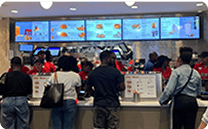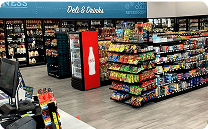Theoretically, it’s easy to spot the difference between an engaged and a disengaged employee. You can look at their quality of work, willingness to collaborate, and overall behaviour in the workplace. But employee engagement can be difficult to quantify and measure – and disengaged employees are more likely to quit. Further if you are a franchisee managing multi-unit stores in the quick service restaurant (QSR) industry for example, your challenges are even greater.
Because employee engagement is directly connected to retention rates, franchisees and managers need to understand this powerful metric.
Employee Engagement and Retention: What’s the Difference?
Employee engagement and retention may be closely connected, but they are distinct. Employee engagement is the level of enthusiasm, connection, and dedication a worker feels toward their job and the company at large. An engaged employee is:
Clear about their role and their specific job duties
Loyal to their employer
Motivated and productive
Invested in the success of their company
Employee retention, on the other hand, is a company’s ability to prevent staff turnover and keep employees. Because engaged employees care about their work, their colleagues, and helping their team succeed, they are less likely to leave for another job. Strong employee engagement, therefore, translates into high employee retention.
Benefits of Higher Retention Rates
High employee retention benefits everyone, including the customers served by the franchise. Here’s how retention affects each stakeholder group:
Management: Hiring and training new staff is expensive and time-consuming. For high-turnover, low-paying jobs it has been estimated managers should expect to pay around 16% of the employee’s salary to replace them.[1]. Replacing a mid-level employee can cost much more. When employee turnover is low, franchisees and managers have more time (and budget) to focus on other priorities.
Employees: High turnover affects both the employees who leave and those who stay. Employees who leave your franchise miss out on company training, development, and advancement opportunities. And those who stay may have to take on additional work while the position is being refilled, which can lead to stress or burnout.
Customers: Knowledgeable and experienced employees are able to ensure a seamless customer experience. In contrast, high employee churn can mean that guests receive slower and lower-quality service as they interact with less-experienced employees.
Shareholders: One study in the US conducted by Gallup estimates that voluntary turnover due to burnout can cost an organisation up to 20% of its payroll budget. Think about it, that can translate into thousands – or millions – of pounds each year, significantly affecting your bottom line.
Overall, low retention rates also significantly affect morale. If the makeup of your team is always changing, your team is less likely to be invested in your collective success. Managers lose the institutional knowledge that these employees hold – and the opportunity to promote them to higher-level positions, which costs less than hiring external candidates.
How to Develop an Employee Engagement Strategy
You want your employees to be happy, engaged, and productive, and you value keeping them feeling that – but do you have a plan in place to achieve that goal? Ad hoc initiatives like employee appreciation days are great, but they’re not enough to build a strong company culture or increase employee engagement.
Smart video systems can play a significant role in success. They can provide insights that help improve every aspect of a customer’s experience and your team’s interaction with them from the moment they enter your establishment. With the ability to support staff with chargeback queries and video evidence to counter customer complaints, it’s therefore, no wonder more businesses are leveraging smart video solutions.
What’s needed to maximise success in the use of such tech in relation to employee engagement is a clear strategy and a comprehensive plan to foster a positive workplace culture, reduce turnover, and keep workers motivated and engaged on an ongoing basis. To build your strategy, take a critical look at each phase of the employee lifecycle at your franchise:
Recruitment: Your employee recruitment efforts and materials should communicate your mission and attract applicants who are passionate about the work you do.
Hiring: Clear position descriptions help you match the right candidates to the right roles.
Training: Employee engagement, retention, and support starts on day one. Make sure your onboarding process is welcoming and comprehensive.
Supervision: Each employee needs to know where to go when they need help. Managers are responsible for communicating clear expectations and providing ongoing support.
Development: Employees are more likely to stay when they have room to grow. Managers should provide training and development opportunities and offer feedback about areas for improvement.
Recognition: Many employees don’t feel recognized at work, so make sure you’re offering praise for outstanding performance.
Departure: When an employee leaves an organisation, management should take the time to conduct an exit interview and understand their reasons for leaving. Exit interviews can provide valuable insights that will help improve your engagement strategy.
Improving Employee Engagement and Retention
Once you have a solid engagement plan, you can focus on ways to improve and refine your engagement tactics. Every franchise is different, so your employee engagement and retention strategies should be customised to your industry and business — this can get as granular as each individual store. But in general, you’ll want to focus on training, support, and communication. Consider the following four practices:
1. Start with the basics
Before you dive into retention strategies, start by clarifying your value proposition: what attracts employees to your franchise? Take a look at your competitors and ensure your wages and benefits are competitive. Review your typical work schedules to make sure that shifts are divided equitably.
2. Gather insights
Your current employees are a big resource – if you want to retain them, you need to understand their perspectives. Consider implementing a staff satisfaction survey to gain insights into what works well and isn’t. Ask employees if they’re receiving meaningful support from their supervisors, and collect data on what would help them stay. This may include more opportunities for advancement, a bonus program, or more schedule flexibility.
3. Track performance
Quantitative data is just as important as the qualitative feedback you collect from staff. Many retail and dining establishments already have the camera and video systems in place. These can be excellent training tools for staff, especially when it comes to implementing health and safety practices or tracking customer engagement.
4. Support your managers
While your retention efforts may be focused on frontline employees, don’t overlook staff members in middle-management roles. Make sure you have the proper training in place to help them do their jobs well and maintain open lines of communication.
Top management won’t have day-to-day contact with entry-level employees, but supervisors do. They’re in a powerful position to communicate your company culture and give on-the-ground insights into employee engagement.
See How Tools Like DTiQ’s Video Surveillance Can Help to Track and Improve Employee Engagement
Looking for ways to improve your employee engagement? DTiQ can help. As a global leader in intelligent video-based surveillance tools, DTiQ serves over 45,000 retail, restaurant, and convenience store customers. We offer customised cloud-based video solutions and comprehensive managed services with subscription-based pricing, so you can efficiently track employee engagement and productivity and instigate positive change.
These days, users can expect their video solutions to offer insights, track key metrics, and generate reports on transaction times, customer conversion, employee behaviour and other trends. With insights like this at franchise owners’ fingertips, analytics can be used to improve business operations, objectively. Often there is no need to upgrade your current CCTV or EPOS to get on board with intelligent video, as the latest tech can work with existing infrastructure.
DTiQ even offers SmartAudits to evaluate team members remotely and provide data-driven insights to improve employee performance. Contact Gareth at: gbakewell@dtiq.com to book a no obligation online demo today for more information about improving employee engagement and retention with DTiQ.
Read more at https://www.whichfranchise.com/























